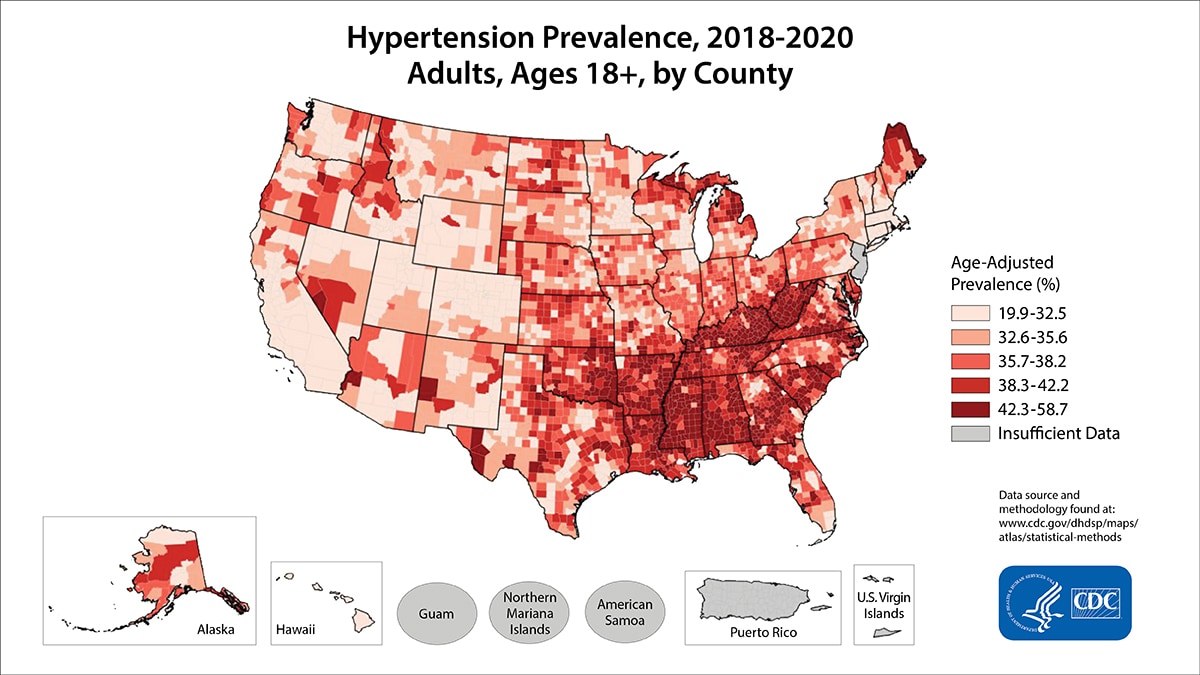What to know
- Blood pressure is the pressure of blood pushing against the walls of your arteries.
- Arteries carry blood from your heart to other parts of your body.

High blood pressure in the United States
Blood pressure is the pressure that occurs when blood pushes against the walls of your arteries. Learn more about the definition of blood pressure.
- Having high blood pressure puts you at risk for heart disease and stroke, which are leading causes of death in the United States.
- In 2023, high blood pressure was a primary or contributing cause of 664,470 deaths in the United States.1
- About 1 in 5 deaths related to COVID-19 were people who had a history of hypertensive disease.1
- Nearly half of adults have high blood pressure (48.1%, 119.9 million). This is defined as a systolic blood pressure greater than 130 mm Hg or a diastolic blood pressure greater than 80 mm Hg or are taking medication for high blood pressure.2
- About 1 in 4 adults with high blood pressure has their blood pressure under control (22.5%, 27.0 million).2
- About half of adults (45%) with uncontrolled high blood pressure have a blood pressure of 140/90 mmHg or higher. This includes 37 million U.S. adults.2
- About 34 million adults who should be taking medication according to hypertension guidelines may need a prescription or to fill their prescription and start taking it. Almost two out of three of this group (19 million) have a blood pressure of 140/90 mm Hg or higher.2
- High blood pressure costs the United States about $131 billion each year, averaged over 12 years from 2003 to 2014.3
Blood pressure differences by sex and race
Uncontrolled high blood pressure is common, but some groups of people are more likely to have control over their high blood pressure than others.
- A higher percentage of men (50%) have high blood pressure than women (44%).2
- High blood pressure is more common in non-Hispanic black adults (58%) than in non-Hispanic white adults (49%), non-Hispanic Asian adults (45%), or Hispanic adults (39%).2
- Among those recommended to take blood pressure medication, blood pressure control is higher among non-Hispanic white adults (32%) than in non-Hispanic black adults (25%), non-Hispanic Asian adults (19%), or Hispanic adults (25%).2
Geographic rates of high blood pressure

High blood pressure is more common in some areas of the United States. Above is a map showing the self-reported rate of hypertension by county. However, this map likely underreports the true effect of hypertension in each state, because about 1 in 5 adults with high blood pressure is unaware of it and would not report having it.4
- National Center for Health Statistics. Multiple Cause of Death 2018–2023 on CDC WONDER Database. Accessed February 1, 2025. https://wonder.cdc.gov/mcd.html
- Centers for Disease Control and Prevention. Hypertension cascade: hypertension prevalence, treatment and control estimates among US adults aged 18 years and older applying the criteria from the American College of Cardiology and American Heart Association's 2017 Hypertension Guideline—NHANES 2017–March 2020. Published 2023. Accessed May 3, 2024. https://millionhearts.hhs.gov/data-reports/hypertension-prevalence.html
- Kirkland EB, Heincelman M, Bishu KG, et. al. Trends in healthcare expenditures among US adults with hypertension: national estimates, 2003-2014. J Am Heart Assoc. 2018;7:e008731.
- Farley TA, Dalal MA, Mostashari F, Frieden TR. Deaths preventable in the US by improvements in the use of clinical preventive services. Am J Prev Med. 2010;38(6):600–609.
- Whelton PK, Carey RM, Aronow WS, et al. 2017 ACC/AHA/AAPA/ABC/ACPM/AGS/APhA/ASH/ASPC/NMA/PCNA guideline for the prevention, detection, evaluation, and management of high blood pressure in adults. Hypertension. 2018;71(19):e13–e115.
